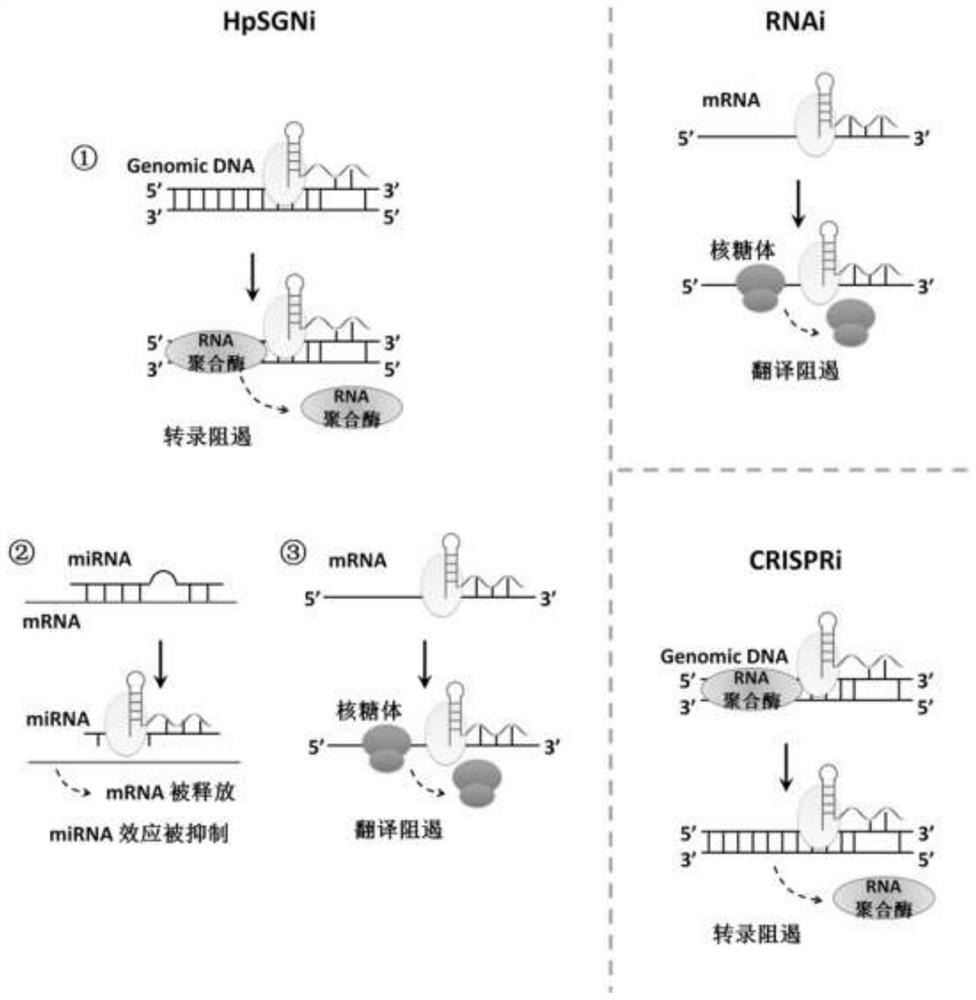Composition and method for regulating any gene expression
A technology of gene expression and gene regulation, applied in the field of molecular biology, to achieve the effect of wide applicability, strong versatility, and beneficial to in vivo delivery
- Summary
- Abstract
- Description
- Claims
- Application Information
AI Technical Summary
Problems solved by technology
Method used
Image
Examples
Embodiment 1
[0045] Example 1
[0046] In order to verify whether the AfuFEN1 protein (the nucleotide sequence is shown in SEQ ID NO.1, and the encoded amino acid sequence is shown in SEQ ID NO.2) can successfully target and bind the target substrate ssDNA under the guidance of the mis-hpDNA probe, Such as figure 2As shown, we designed several probes with a stem-loop structure at the 3' end of these probes, and the 5' end was basically complementary to the target ssDNA, but did not match the target ssDNA at some specific positions. The expressed and purified AfuFEN1 protein was incubated with these probes at 37°C for 20 min, and then ssDNA was added to incubate for 30 min, and the reaction products were analyzed by EMSA.
[0047] Such as figure 2 As shown, when there is no mismatched base on the probe (PC group, hp4-17), the substrate in the swimming lane is almost completely cut (marked as cleavage product); when the mismatched base on the probe is in position 1 (hp4-17-m1), there i...
Embodiment 2
[0049] Example 2
[0050] In order to investigate whether AfuFEN1 protein can fully bind the target substrate ssDNA under the guidance of mis-hpDNA, such as image 3 As shown, we gradually increased the amount of AfuFEN1 protein. As the ratio of FEN1 protein to the target ssDNA continued to increase, the amount of the "ssDNA-probe-FEN1" ternary complex gradually increased, indicating that AfuFEN1 was involved in mis-hpDNA probes. Guided by (hp4-17-m), it can better bind to the target substrate (ssDNA-S2).
[0051] In order to further improve the binding efficiency, we increased the complexity of the stem-loop structure at the 3' end of the mis-hpDNA probe, respectively version 1.0 (hp4-19-m-ver1.0), 1.1 (hp4-19-m- ver1.1), 1.2 (hp4-19-m-ver1.2) and 1.3 (hp4-19-m-ver1.3) probes. Such as Figure 4 As shown, as the complexity of the stem-loop structure increases, the amount of the "ssDNA-probe-FEN1" ternary complex also gradually increases. The above results indicated that A...
Embodiment 3
[0054] Example 3
[0055] In order to investigate whether AfuFEN1 can bind target substrate RNA under the guidance of mis-hpDNA probe, such as Figure 5 As shown, we expressed and purified AfuFEN1 protein with 1.0 (hp4-19-m-ver1.0), 1.1 (hp4-19-m-ver1.1), 1.2 (hp4-19-m-ver1.2 ) and version 1.3 (hp4-19-m-ver1.3) of the mis-hpDNA probe were incubated at 37°C for 20 minutes, and then the target substrate ssRNA (ssRNA-S2) was added for incubation for 30 minutes, and the reaction products were analyzed by EMSA. The ternary complex composed of "ssRNA-probe-FEN1 protein" marked by the dotted line box can be observed; this result shows that AfuFEN1 can efficiently bind the RNA target substrate under the guidance of the mis-hpDNA probe.
[0056]
PUM
| Property | Measurement | Unit |
|---|---|---|
| molecular weight | aaaaa | aaaaa |
Abstract
Description
Claims
Application Information
 Login to View More
Login to View More - R&D Engineer
- R&D Manager
- IP Professional
- Industry Leading Data Capabilities
- Powerful AI technology
- Patent DNA Extraction
Browse by: Latest US Patents, China's latest patents, Technical Efficacy Thesaurus, Application Domain, Technology Topic, Popular Technical Reports.
© 2024 PatSnap. All rights reserved.Legal|Privacy policy|Modern Slavery Act Transparency Statement|Sitemap|About US| Contact US: help@patsnap.com










